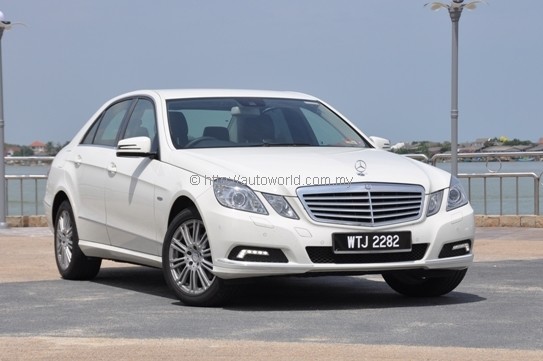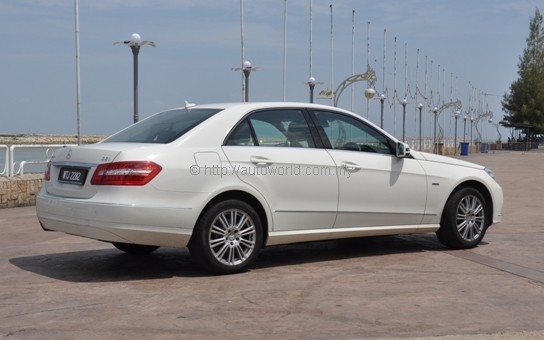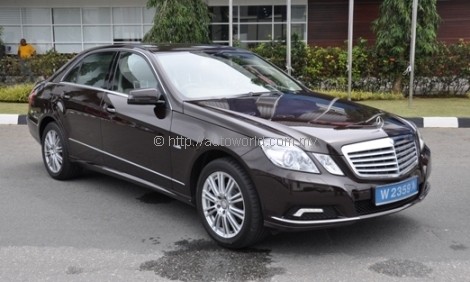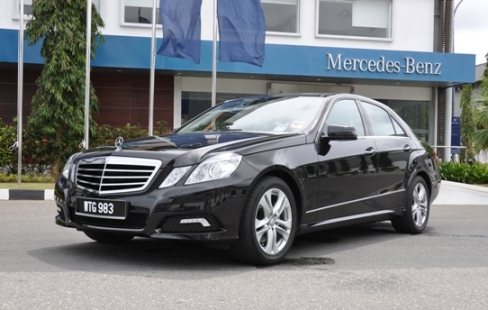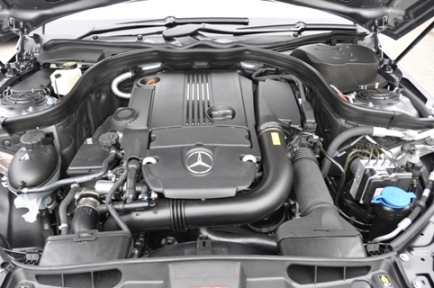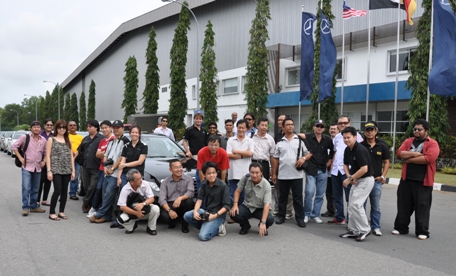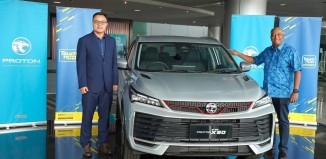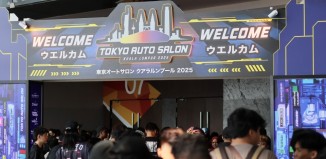Mercedes-Benz E Class Tested
The 2010 Mercedes-Benz E Class continues as the desired car for businessmen and top executives in Malaysia, and sets new benchmarks for other car makers to follow. It does not look very different from the outgoing model at first glance, because the main DNA, such as the large Mercedes grille, and the familiar three-pointed star remains up front for all to see, but upon a closer look, you will note there are new character lines, making it look more angular – it remains roughly the same size, with many mechanical carry-overs. However, the smaller engined E 200 comes with a CGI (Charged Gasoline Injection) engine that carries a turbocharger in place of the supercharger or ‘Kompressor’. The introduction of the CGI brings the performance of the E 200 several notches up, and those who enjoy driving will appreciate it more now.
The new E Class comes with a totally new body that is about the same size as the outgoing model, but appears to be a little more compact visually; this is due to some changes in the overall profile and character lines along the sides that break up the monotony of a large sedan, but inside, it is as spacious as ever. One can never really describe a car fully using words, but all and sundry do agree that this is a great looking car.
Under the bonnet, what is available is a few engine variants, and basically two transmission options to suit personal and pocketbook preferences. The entry level engine is a 1.8 litre DOHC unit that uses the same block as the previous model, but with a re-designed cylinder head, and in the place of the supercharger, is a turbocharger unit, with a new engine control unit to manage the new configuration. The 1.8 litre engine, now dubbed the CGI (Charged Gasoline Injection) is mated to a 5-speed automatic gearbox, and is sold as the E200. The latest addition to the product portfolio is the E 250, with a 2.5 litre naturally aspirated engine carried over from the E230, which we hope to be able to test soon
Also available is a 3.0 litre V6 engine mated to a 7-speed automatic gearbox, and this is the same configuration that was available as the E280 in the previous line-up. Coincidentally, this engine / transmission combination is also identical to that in the S300 model. All these models will be sold as CKD models, and are assembled at the CDR-HICOM plant in Pekan, Pahang.
The media took a long drive in the new Mercedes-Benz E Class, and I was a part of it. The trip took us from Kuala Lumpur to Tg Jara Resort in Kuala Dungun, Terengganu, with a stop over at the Pekan plant to view the assembly plant where these cars are put together under the watchful eyes of German engineers from the mother plant in Germany. The entire trip to and fro covered approximately 950 kilometres, a distance that is long enough for one to either be utterly disappointed with the car, or fall in love with it.
We had the opportunity to drive the newly launched E300, and fresh from the plant in Pekan, having been sent by trailer down to Kuala Lumpur just the day before, were another six brand spanking new E200 units with the CGI engine.
Although there are some specification differences between the E200 and the E300, there are very few visual differences between the two, the main being the wheel design and the model badge at the rear of the car. The E300 comes with a drowsiness detection system aptly called “Attention Assist”, adaptive high beam assist, and DIRECT CONTROL suspension system that adjusts to the driving situation.
The E300, by virtue of its larger engine capacity, has everything going for it, and it is a cinch to drive – powerful, composed, silent, and elegant. Like the E280 before it, the E300 has no bad habits, and it will continue to provide its owner satisfaction throughout its useful life. In addition, it is very agile despite its size. There is really nothing I can say about it except perhaps that it delivers everything as promised, and should you decide to pay the price of RM455, 888.00 (on-the-road) for it.
The E200 is a different kettle of fish altogether. With 184 horses and 270 Nm of torque from the now turbo charged engine, it certainly delivers more than one would expect from a 1.8 litre engine. If I did not mention it, no one driving one would even think that it only has such a small displacement. To bring everybody up to speed, the decision to stay with a 1.8 litre instead of increasing the capacity is in line with the Mercedes-Benz philosophy and aim to reduce overall fuel consumption in Mercedes-Benz cars by ten percent, an exercise that was started a couple of years ago. Downsizing engine displacement, increasing fuel efficiency, and reducing vehicle weight are some of the measures adopted. As it is, the E200 can deliver outstanding fuel economy, and on my drive, which included some fast driving along the B roads of Terengganu, the E200 could return a (real world) figure of 9.5 litres per 100 kilometres, which is what I am getting on my 1.6 litre national car.
With turbo charging, the E200 makes more horsepower and torque, and new engine management software and transmission management software contribute towards better power while increasing fuel efficiency. With the new power train, the E200 takes on a new character, and as a result of the increased power, and the resultant responsiveness, the E200 is just as enjoyable to drive as the E300. In fact, most of the media who were there on the trip had nothing but praises for the E200, with some commenting that it makes more sense to buy the E200 on account of it being able to deliver the same level of driving pleasure as the E300, besides being a good RM89k cheaper with its on-the-road price of RM366, 888.
On a follow-up test during which I took the E200 to Kuala Terengganu and back, the fuel consumption figure above was verified, and this time I sat at the back for a long stretch, basking in the comfortable ride; the E200 at 160 km/h feels like 120 km/hr in a normal car, and I managed 235 km/h on a short open stretch when the road was completely clear of traffic. It will cruise all day at anything between 160 – 180 km/h without any stress, should you be required to do so. Should you drive it sedately at the regulation speed limits, you can expect a fuel consumption figure of around 7.5 litres per 100 kilometres.
Wrapping up, I would say that Mercedes-Benz have done it again – they have come up with a series of cars that are worthy successors of the E Class – these cars will continue to be class leaders, until some other car maker comes up with something better.




